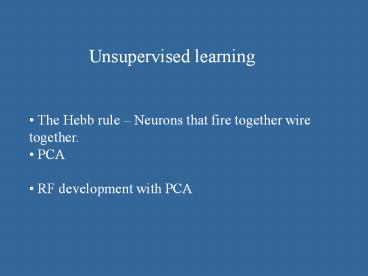The Physics of the Brain PowerPoint PPT Presentation
1 / 21
Title: The Physics of the Brain
1
- Unsupervised learning
- The Hebb rule Neurons that fire together wire
together. - PCA
- RF development with PCA
2
Classical Conditioning
3
Classical Conditioning and Hebbs rule
Ear
A
Nose
B
Tongue
When an axon in cell A is near enough to excite
cell B and repeatedly and persistently takes
part in firing it, some growth process or
metabolic change takes place in one or both
cells such that As efficacy in firing B is
increased
D. O. Hebb (1949)
4
The generalized Hebb rule where xi are
the inputs and y the output is assumed
linear Results in 2D
5
Example of Hebb in 2D
w
(Note here inputs have a mean of zero)
6
- On the board
- Solve simple linear first order ODE
- Fixed points and their stability for non linear
ODE. - Describe potential and gradient descent
7
In the simplest case, the change in synaptic
weight w is where x are input vectors and y is
the neural response. Assume for simplicity a
linear neuron So we get Now take an average
with respect to the distribution of inputs, get
8
If a small change ?w occurs over a short time ?t
then (in matrix notation) If ltxgt0 , Q is
the covariance function. What is then the
solution of this simple first order linear ODE ?
(Show on board)
9
Mathematics of the generalized Hebb rule
The change in synaptic weight w is where x are
input vectors and y is the neural
response. Assume for simplicity a linear
neuron So we get
10
Taking an average of the distribution of
inputs And using and We
obtain
11
In matrix form Where J is a matrix of ones, e
is a vector in direction (1,1,1 1),
and or Where
12
The equation therefore has the form
If k1 is not zero, this has a fixed point,
however it is usually not stable. If k10 then
have
13
The Hebb rule is unstable how can it be
stabilized while preserving its properties? The
stabilized Hebb (Oja) rule.
Where Appoximate to first order in ? Now
insert Get
Normalize
14
y
Therefore The Oja rule therefore has the
form
15
Average
In matrix form
16
- Using this rule the weight vector converges to
- the eigen-vector of Q with the highest
eigen-value. It is often called a principal
component or PCA rule. - The exact dynamics of the Oja rule have been
solved by Wyatt and Elfaldel 1995 - Variants of networks that extract several
principal components have been proposed (e.g
Sanger 1989)
17
Therefore a stabilized Hebb (Oja neuron) carries
out Eigen-vector, or principal component analysis
(PCA).
18
Using this rule the weight vector converges
to the eigen-vector of Q with the highest
eigen-value. It is often called a principal
component or PCA rule.
Another way to look at this Where for the Oja
rule At the f.p
where So the f.p is an eigen-vector
of Q. The condition means that w
is normalized. Why? Could there be other
choices for ß?
19
- Show that the Oja rule converges to the state
w21 - The Oja rule in matrix form
- Multiply by w, get
- Bonus question for H.W
- The equivalence above
- That the direction of the PC is the direction of
maximal variance (HKP pg 202)
20
Show that the f.p of the Oja rule is such that
the largest eigen-vector with the largest
eigen-value (PC) is stable while others are not
(from HKP pg 202). Start with Assume
wuaeub where ua and ub are eigen-vectors with
eigen-values ?a,b
21
Get (show on board) Therefore That
is stable only when ?agt ?b for every b.

